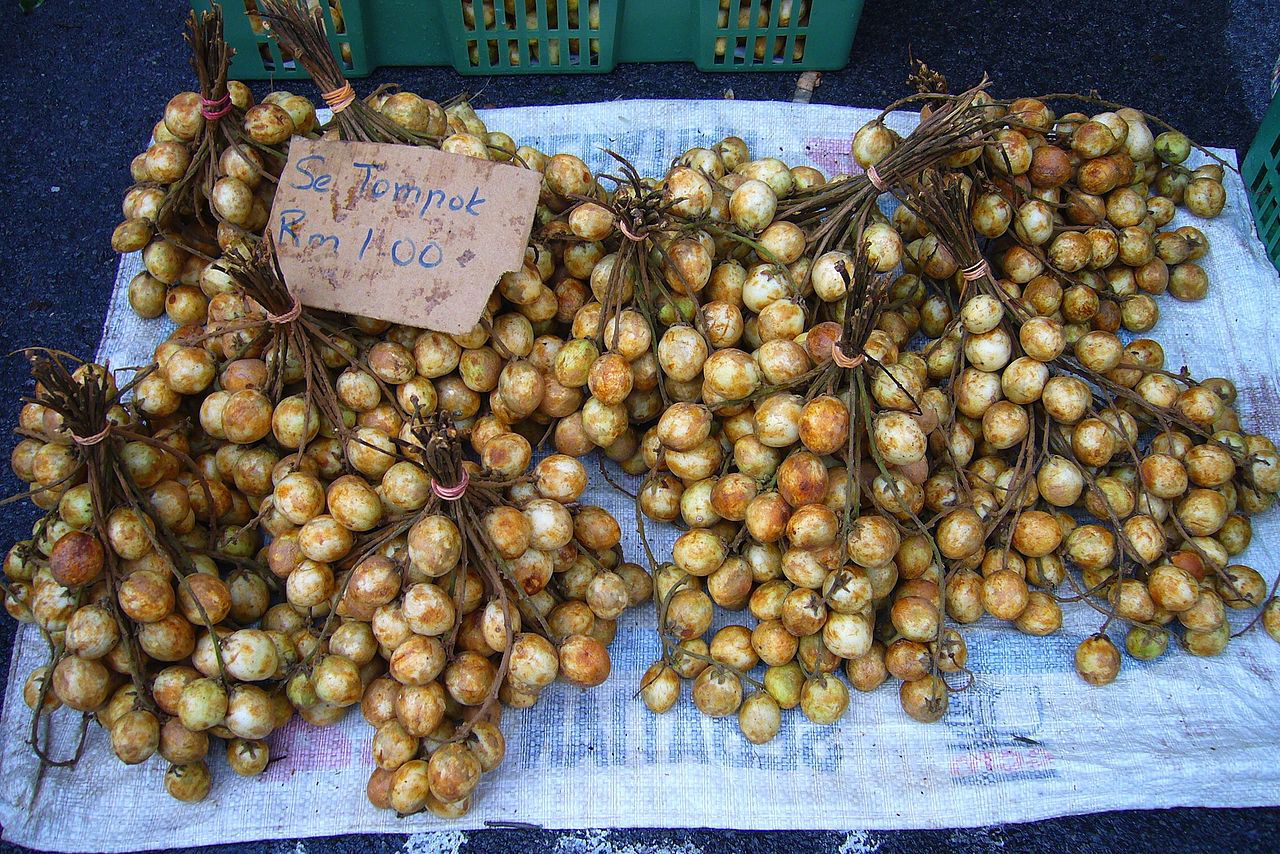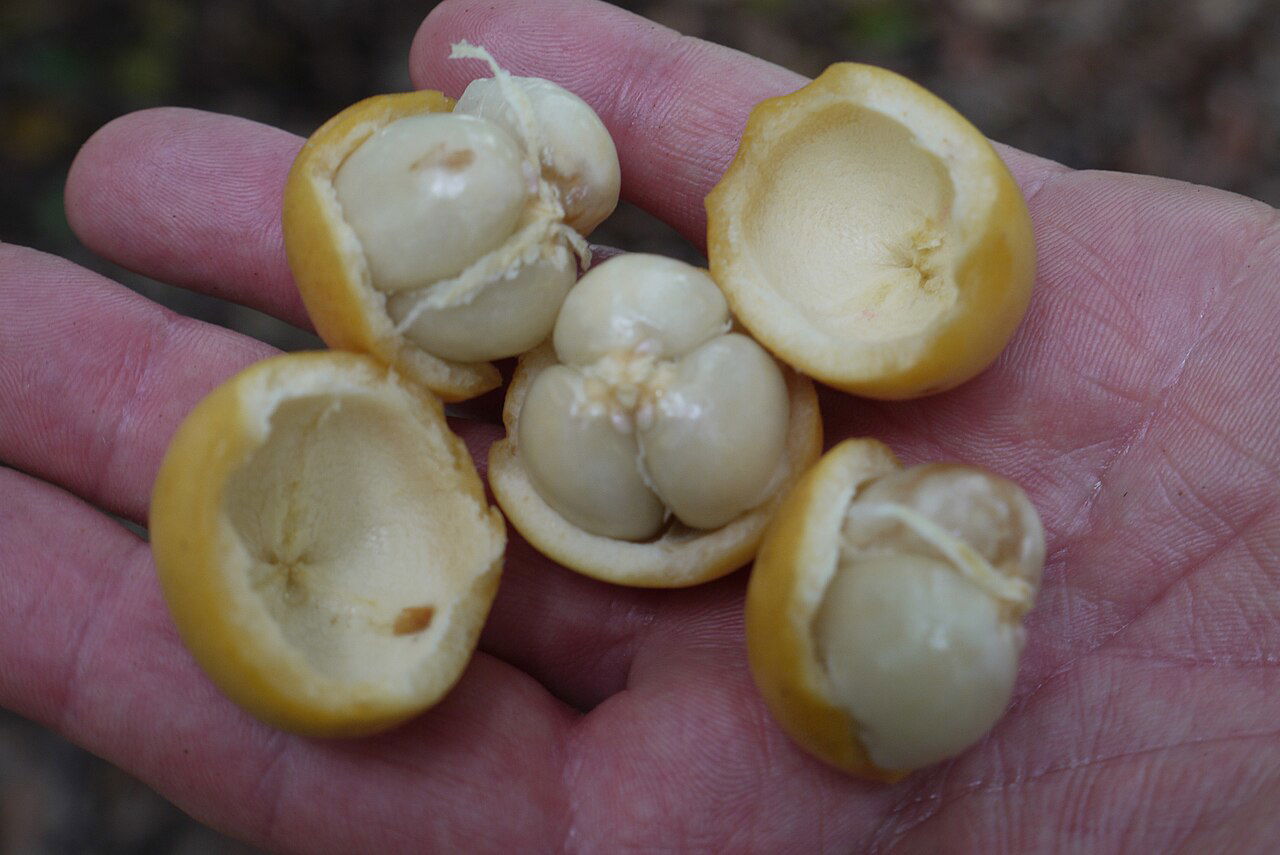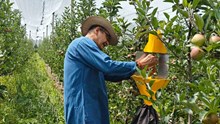
Rambai (Baccaurea motleyana) is a medium-sized tree, reaching heights of 9 to 12 meters. It has a short trunk and a wide, dense canopy that provides ample shade. The leaves are evergreen, dark green on the upper surface, and slightly hairy underneath. They are elliptical and can grow up to 33 cm in length. The tree is dioecious, meaning male and female flowers grow on separate trees. These flowers, small and yellowish, are aromatic and bloom in long clusters along the branches.
The fruit of Rambai is small, measuring between 2 to 5 cm in diameter. It grows in dense clusters along the branches, similar to other fruits like langsat and duku. The outer skin is thin, velvety, and ranges from pale yellow to brown when ripe. Inside, the fruit contains a translucent, whitish pulp that encases 3 to 5 seeds. The pulp has a juicy texture with a sweet to mildly acidic flavor.
The species name motleyana honors botanist James Motley, who collected it in southeast Borneo. Rambai is known by various common names, including rambi and rambai. In Thai, it is called ‘mafai-farang.’ In the Bengali-speaking regions, especially in Narsingdi, it is locally referred to as lotka, lotkon, or bubi, while in Assamese, it is known as leteku.
Rambai: Cultivation and Harvesting
Rambai trees flourish in tropical climates with warm temperatures and high humidity. They are typically grown from seeds but can also be propagated through grafting. The trees require well-drained soil and benefit from regular watering during dry seasons. Rambai takes about 5 to 7 years to mature and begin fruiting. The fruiting season varies by region but typically falls between June and September.
Harvesting is done manually by cutting the fruit clusters from the tree. Since the fruit ripens quickly, it is best consumed fresh or preserved within a short period. Farmers often sell Rambai in local markets, where it is a seasonal delicacy.
Nutritional Value & Health Benefits
Rambai is not only delicious but also packed with essential nutrients. It is rich in Vitamin C, dietary fiber, and antioxidants, along with vital minerals such as phosphorus, calcium, and potassium.
It has many health benefits like-
1. Improves Digestion
Rambai is high in dietary fiber, making it beneficial for the digestive system. It promotes bowel regularity and helps prevent constipation. The fruit also contains natural enzymes that aid in breaking down food and improving nutrient absorption.
2. Supports Heart Health
Potassium in Rambai helps maintain healthy blood pressure levels by balancing sodium in the body. Regular consumption may reduce the risk of hypertension and cardiovascular diseases. Additionally, antioxidants in the fruit help prevent oxidative stress, which is linked to heart problems.
3. Boosts Immunity
With a significant amount of vitamin C, Rambai strengthens the immune system. It enhances the body's ability to fight infections and reduces the severity of colds and flu. The fruit also supports collagen production, which is vital for skin health and wound healing.
4. Promotes Healthy Skin
The antioxidants and vitamin C in Rambai contribute to youthful and glowing skin. They help combat free radicals that cause premature aging, wrinkles, and skin damage. Regular consumption of Rambai may improve skin elasticity and reduce blemishes.
5. Helps in Control of Blood Sugar Levels
Some studies suggest that Rambai may help regulate blood sugar levels. Its fiber content slows down glucose absorption, preventing sudden spikes in blood sugar. This makes it a good fruit option for individuals managing diabetes or insulin resistance.
6. Anti-Inflammatory and Pain Relief
In traditional medicine, various parts of the Rambai tree, including the bark and leaves, are used for their anti-inflammatory properties. They are applied to wounds and sores to reduce swelling and pain. The fruit is also believed to alleviate symptoms of arthritis and muscle pain.
Culinary Uses of Rambai
Rambai is a versatile fruit that can be enjoyed in various ways. It is commonly eaten fresh, where the pulp is sucked out of the skin and discarded. The flavor is refreshing, making it a popular snack in tropical regions.
1. Raw Consumption
The simplest way to enjoy Rambai is to eat it raw. The fruit is peeled, and the flesh is eaten by sucking the pulp away from the seeds. Some people enjoy mixing it with sugar or salt to enhance the taste.
2. Jams and Preserves
Due to its natural sweetness, Rambai is ideal for making jams, jellies, and fruit preserves. The pulp is cooked with sugar and lemon juice to create a spreadable fruit jam that pairs well with toast and pastries.
3. Juices and Beverages
Rambai is sometimes blended into juices or smoothies. It can also be fermented to make wine or mixed into cocktails for a tropical twist.
4. Curries and Stews
In some regions, Rambai is used as an ingredient in savory dishes. It adds a tangy flavor to curries, stews, and chutneys, balancing the richness of meats and spices.
Economic and Cultural Significance
Rambai holds cultural importance in Southeast Asian countries. It is often found in home gardens, where it provides shade and fruit for families. In Malaysia and Indonesia, it is commonly sold in local markets during the fruiting season, contributing to the livelihood of small-scale farmers.
In India and Bangladesh, Rambai (locally known as Lotkon) is a popular fruit in rural areas. It is not only a nutritious food source but also generates income for farming communities. Efforts to cultivate Rambai commercially could enhance its availability and economic value.

Conservation and Challenges
Despite its popularity in local communities, Rambai is under threat in some regions due to deforestation and urbanization. In Singapore, for example, Baccaurea motleyana is considered critically endangered. Conservation efforts, such as planting more trees and promoting sustainable farming practices, are necessary to protect this species.
Additionally, the fruit's short shelf life poses a challenge for large-scale distribution. Research on better storage methods or processing techniques, such as drying or canning, could help extend its usability and market reach.
Rambai is a remarkable tropical fruit with numerous benefits. From its nutritional value to its medicinal properties and economic potential, it remains an important part of Southeast Asian agriculture and culture. While relatively unknown outside its native regions, greater awareness and cultivation efforts could introduce Rambai to a wider audience. As we continue to explore the richness of tropical fruits, Rambai stands out as a delicious and health-enhancing choice worthy of more recognition.
















